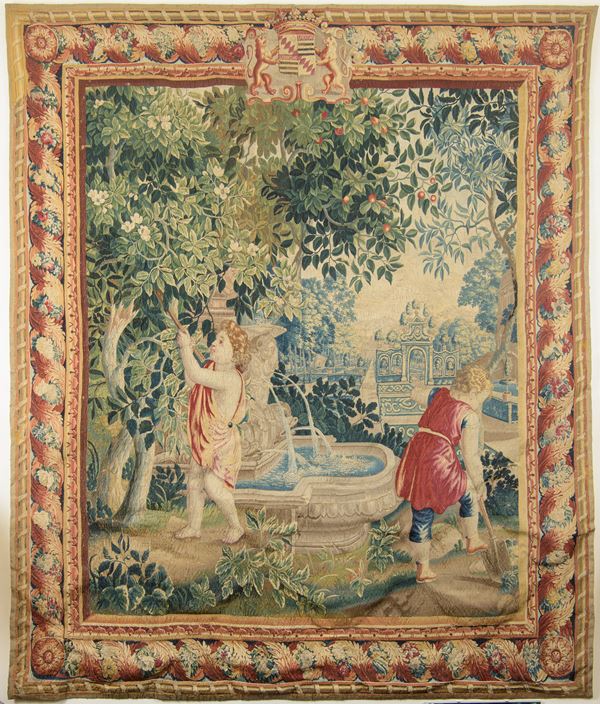28
Charles Le Brun (Francia, 1619 - 1690)d'apres
Gobelins Royal Manufactory - Tapestry from the series "Les Enfants Jardiniers", France, early 18th century
wool and silk
320 x 255 cm
This splendid silk tapestry, depicting a child digging and a boy shaking a cherry tree, is part of the series known as " Les Enfants Jardiniers" , made in Lille by the Gobelins manufactory (founded by Jean Baptiste Colbert, under Louis XIV) at the beginning of the 18th century. The first drawings for this series were made by Charles Le Brun in 1664, who, as director of the Gobelins tapestry manufactory from 1662 to 1690, supervised the various weavings of the series.
The first tapestry, dating back to 1664, consisted of eight horizontal scenes depicting putti engaged in various gardening tasks, today visible in the Pavillon de l'Aurore in the Parc de Sceaux in Paris. Le Brun later developed this concept differently and transformed the first series into allegories of the Four Seasons depicting children, rather than putti, engaged in gardening tasks in elaborate gardens. From these drawings several series of tapestries were drawn, called precisely "Les Enfants Jardiniers".
At Gobelins, under the direction of Le Brun, three versions of "Les Enfants Jardiniers" were produced, designed by Sève le Cadet, from the Director's drawings. Two of these weavings, completed by 1685, originally intended for the minister Colbert, were requisitioned by the king who used them as diplomatic gifts.
The first exclusively royal commission of this series dates back to 1703: this weaving, now exhibited in Versailles, was composed of 6 tapestries: Spring, Summer, Autumn, Winter, an additional version called "Grand Pieces du Printemps" and a version called "Petite Piece d'Automne". From the Gobelins archives, it is possible to trace eight different weavings of the series designed by Le Brun, carried out between 1685 and 1720.
Provenance: Piero Betti Gallery, Via del Babuino, Rome;
Purchased there by the current owners.
The first tapestry, dating back to 1664, consisted of eight horizontal scenes depicting putti engaged in various gardening tasks, today visible in the Pavillon de l'Aurore in the Parc de Sceaux in Paris. Le Brun later developed this concept differently and transformed the first series into allegories of the Four Seasons depicting children, rather than putti, engaged in gardening tasks in elaborate gardens. From these drawings several series of tapestries were drawn, called precisely "Les Enfants Jardiniers".
At Gobelins, under the direction of Le Brun, three versions of "Les Enfants Jardiniers" were produced, designed by Sève le Cadet, from the Director's drawings. Two of these weavings, completed by 1685, originally intended for the minister Colbert, were requisitioned by the king who used them as diplomatic gifts.
The first exclusively royal commission of this series dates back to 1703: this weaving, now exhibited in Versailles, was composed of 6 tapestries: Spring, Summer, Autumn, Winter, an additional version called "Grand Pieces du Printemps" and a version called "Petite Piece d'Automne". From the Gobelins archives, it is possible to trace eight different weavings of the series designed by Le Brun, carried out between 1685 and 1720.
The tapestry presented here depicts two children intent on working in the heart of a magnificent French garden. In the background, one can see architecture reminiscent of classical gardens, rich vegetation and a fountain on the left. The child, portrayed from three-quarters back, dressed in red, appears identical to the tapestry Le Printemps (Spring) of which several examples are preserved in the Palazzo Pitti in Florence. The other child appears intent on picking cherries from the tree, and is taken from the composition for L'Été (Summer), an example of which is preserved in the Mobilier National in Paris.
The lateral border of the tapestry is enriched by acanthus leaves intertwined with floral garlands and in the centre, at the top, two lions support the coat of arms of Bardo dei Bardi Magalotti (1630-1705), lieutenant general of the French guards (from 1676) and governor of Valenciennes. Bardo was able to add to his surname that of his maternal uncle, Lorenzo Magalotti, starting in 1645 by royal authorization, the latter therefore being the obvious date post quem for the creation of the tapestry, as can be seen from the banner in which the two family crests appear united in a single coat of arms. From the sources we know that from an adolescent he was able to acquire a deep familiarity with both the king, Louis XIV, and with Mazarin, a relationship that was consolidated thanks to numerous victories and military participation in the services of the French crown. It is therefore possible that the tapestry was a royal gift, as a seal of the decades-long friendship and loyalty always demonstrated by Bardo Magalotti.
A remarkable aspect of this tapestry is the freshness of its colors, which have remained extraordinarily vivid thanks to the quality of the weaving. The work is in an excellent state of conservation and has benefited from a maintenance restoration.
Provenance:
Purchased there by the current owners.
Reference bibliography:
M. Fenaille, État général des tapisseries de la manufacture des Gobelins , Paris, 1903, p. 92, ill. 1;
J. Vittet, A. Brejon de Lavernée, La collection de tapisseries de Louis XIV , Dijon, 2010.
"Le Printemps. Spring. Rocket -Powered. 1700 - 1799 (?)", Palazzo Pitti, Florence, in General Catalogue of Cultural Heritage, URL: https://catalogo.cultura.gov.it/detail/HistoricOrArtisticProperty/0900646553
€ 20.000,00 / 40.000,00
Estimate
20.000,00 €
Starting price
€
Your bid
(The reserve price has not been exceeded)
(The reserve price has been exceeded)
Set your maximum bid




